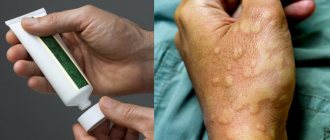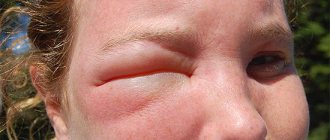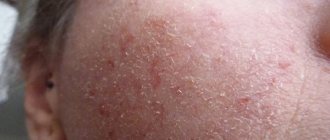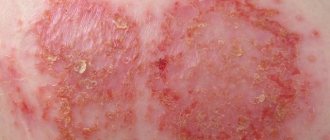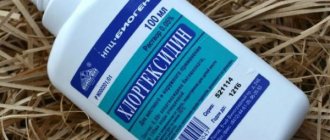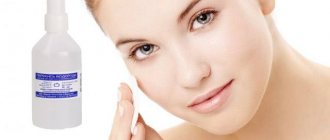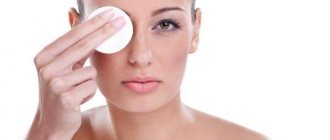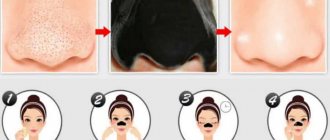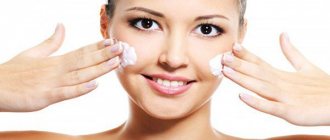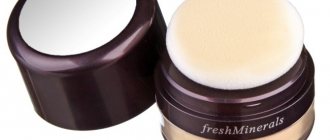How often does it occur
Decorative cosmetics are designed to enhance a person's attractiveness, but they can negatively affect the body.
These products are used by about 65% of women, and each of them has at least once experienced sensations such as itching, burning and flaking of the skin after applying powder, lipstick, mascara or other products.
As for men, they rarely have problems. Only 30% of them experienced allergic manifestations.
Women under the age of 30 with dry and sensitive skin are more prone to the problem.
Facial allergies due to cosmetics. How to treat allergies to cosmetics
Allergy to cosmetics - hypersensitivity to substances included in cosmetics (creams, varnishes, shampoos, lipsticks, perfumes, deodorants, paints, etc.).
It is characterized by the development of allergic reactions affecting the skin, lips, hair and nails. Allergies to cosmetics often manifest themselves in the form of urticaria and contact dermatitis; the upper respiratory tract is less often affected (rhinitis, broncho-obstruction). Diagnosis includes medical history, clinical examination, skin patch tests and laboratory tests. Treatment involves avoiding problematic cosmetics, using antihistamines and topical glucocorticosteroids. Allergy to cosmetics is an increased sensitivity of the body to certain cosmetic products and the components contained in them with the development of a delayed-type allergic reaction (with urticaria and allergic contact inflammation of the skin) or non-immunological reactions (with simple dermatitis). According to statistics, every adult uses at least 5-7 cosmetic products daily, while at least one case of intolerance is observed during the life of every tenth inhabitant of our planet. Most often, allergic reactions occur in women aged 20-30 years, especially if they have dry and damaged skin. In the USA, from 50 to 150 thousand cases of intolerance to cosmetic products are detected annually.
Causes of allergies to decorative cosmetics
Deterioration in well-being after using decorative cosmetics is associated with:
- using low quality products;
- wrong lifestyle;
- sudden climate change;
- weakened immune system;
- unfavorable environmental situation.
Unpleasant side effects are caused by substances in their composition. Allergy symptoms occur upon contact with:
- Synthetic flavors. They contain neurotoxins, so they are more likely to cause problems.
- Glycol. To help the cream penetrate better into the layers of the skin, polyethylene glycol is added to it.
- Parabens. These are preservatives that prevent the growth of bacteria in products.
- Vaseline. It is produced by distilling gasoline and is considered a probable carcinogen.
- Sodium sulfate, which is present in shampoos and gels to increase the amount of foam.
- Triclosan. This is an antibacterial component.
- Aluminum salts. They cause skin irritation.
- Mineral oils, instead of which technical ones are often added. They provide moisture to the skin but contain toxins.
- Retinol. Large doses of the substance dry out the skin.
Expensive brands of cosmetics contain natural ingredients, so they are less likely to cause allergies.
Treatment options
Avoiding inappropriate cosmetics temporarily helps you avoid allergies. However, it does not guarantee that the body will not react to something else. Like any disease, allergies require mandatory treatment.
Medicines
Drug treatment should be prescribed by a doctor after a preliminary examination. It is the basis of therapy due to its high efficiency. The following means are used:
- Antihistamines.
Relieves allergy symptoms in various areas of the skin. Such agents as Suprastin, Tavegil, Claristin, Fenistil, Erius, Zyrtek and others are used.
- Medicinal ointments.
Suitable for treating allergies on the face, eyes and lips. They are divided into types according to purpose of use. They are antibacterial (Levosin, Levomikol, Fucidin, etc.), hormonal, corticosteroid (Advantan, Elkom, etc.), wound healing (Videstim, Solcoseryl, Actovegin, Radevit, etc.), antipruritic (Fenistil-gel , Psilo-balm, etc.).
- Calcium preparations.
Calcium gluconate is widely used. Increases the effectiveness of therapy by influencing the permeability of vascular cells and connective tissue cells. Speeds up recovery.
- Sorbents (activated carbon, lactofiltrum, enterosgel).
They are used during the treatment period to cleanse the body of waste and toxins.
Folk remedies
Used as an addition to the main treatment. Folk remedies relieve external signs of allergies and improve the overall condition of the skin.
Rubbing
Rubbing is carried out in the morning and evening or to alleviate the condition during an exacerbation.
Natural ingredients are used that care for the skin of the face, eyes and lips and relieve swelling, irritation and inflammation.
- Universal decoction.
Pour 4 sachets or 4 tsp. chamomile 500 ml boiling water. Leave for an hour. Use a cotton pad to wipe your eyes and wash your face. Apply daily. Store the finished broth in the refrigerator for no more than 5 days.
- Kefir.
Soak a cotton pad in kefir and wipe your face. Use daily until recovery.
- Sage.
Pour 2 tbsp. l. sage 500 ml boiling water. Leave for 40-60 minutes. Use for daily wiping of facial skin. Store for no more than 5 days in the refrigerator.
- Black tea.
Pour 200 ml of boiling water over 2 bags of black tea. Cool. Wash your face with tea, apply the tea bags to your eyes and leave for 10-15 minutes.
Applications and compresses
They have a local soothing, anti-inflammatory and disinfectant effect. Apply directly to inflamed areas of the skin 2-3 times a day.
- Starch.
Cover the affected area of facial skin with a thick layer of rice or potato starch. Leave the compress on for 40 minutes. Remove residues with a cloth moistened with boiled water.
- A series.
Add 2 tsp to a glass of boiling water. successions. Cool. Fold gauze in 3-4 layers, moisten with infusion and apply the application to the affected area of the face or area around the eyes. Leave for 20 minutes.
- Chamomile.
Apply a gauze bandage soaked in chamomile infusion to your eyes and leave for a quarter of an hour.
- Boric acid.
Dilute the acid with water in a 1:1 ratio. Soak a cotton pad or gauze bandage in the solution and apply to the skin. Leave for 10 minutes. After the time has passed, wash with plenty of warm water.
- Soda.
Dilute 1 tsp in a glass of warm water. soda Apply the solution to a cotton pad and apply to the skin of the face. Leave the compress for 10-15 minutes. Rinse off any remaining product with water.
Water solution
Internal intake of aqueous solutions of medicinal plants helps treat allergies. The following options are effective:
- Duckweed.
Pour 1 tbsp. l. herbs 200 ml boiling water. Leave for an hour. Then strain. Take 1/3 cup 3 times a day.
- Mumiyo.
Dilute 1 g of herb into 1 liter. water. Leave for an hour, then strain. Take 100 ml daily. The course is 21 days.
- Dandelion.
Mix dandelion juice and water in a ratio of 1:2. Bring the solution to a boil. Take 30 ml before each meal.
Types of decorative cosmetics that most often cause allergies
The most common allergy is considered to be allergy to moisture-resistant mascara. Also, unpleasant phenomena occur when using expired products:
- Dry products such as powder, blush and eye shadow can be used for no longer than three years from the date of manufacture.
- The creams last for a year. After this you need to buy a new product.
- Foundation and mascara last for several months, after which they need to be changed.
- Lipstick is harmless to health for no more than a year.
Deterioration in well-being can be observed when using different types of decorative cosmetics, so you need to carefully study the composition.
Treatment
The presence of such violations requires a professional approach to the problem. In some cases, a woman requires drug treatment. Health measures to eliminate an allergic reaction involve prescribing ointments and taking antihistamines orally.
As an external effect on the inflammatory reaction, the patient is prescribed the following facial ointments:
- with antipruritic properties: Psilo-balm and Fenistil-gel;
- with antibacterial effects: Levomekol, Levosin, Fucidin;
- with a wound-healing effect: Actovegin, Solcoseryl, Videstim, Radevit;
- corticosteroid and hormonal drugs: Elcom, Advantan.
For internal use, representatives of the fair sex can use antihistamines:
- Tavegil;
- Suprastin;
- Claristin;
- Diazolin.
If the patient’s allergic reaction is not accompanied by severe symptoms, then the specialist can supplement drug treatment with traditional recipes. However, you should not use unconventional measures on your own; this can only aggravate the course of the inflammatory process.
Characteristic symptoms
The most common problem that occurs when using products is contact dermatitis.
This option is the easiest to determine, since it appears immediately after application. In this case, the area where the product is applied swells, itches, turns red and a rash appears. If contact with the allergen is not eliminated, the symptoms will intensify until angioedema occurs. Also, after using decorative cosmetics, the skin begins to peel, turns red, and blisters appear.
Photosensitivity is a fairly rare symptom. This is possible if the allergen came into contact with sunlight and a chemical reaction began. The reaction accumulates gradually, so it is not always possible to immediately identify the problem.
An allergy to mascara manifests itself as symptoms such as swelling and redness of the eyelids. Itching also appears.
If treatment is not started on time, there is a risk of complications.
Allergy to a cosmetic mask. Allergy to face mask
There are various components in a face mask, which can cause negative effects on the body. Such as a rash, itching or swelling, all this can be called in one word - allergy.
Anyone can suffer from this, but most of all - people who have thin and sensitive skin, which, in addition, is also dry.
Causes of allergies
The main factor is individual intolerance to one of the components of the mask. Which may include dye, fragrance and various preservatives. Preservatives are used in cosmetics to enable long-term storage, and these are usually strong chemical elements. For a pleasant smell, fragrances are used; they can be natural or artificial. Both of them can provoke an allergic reaction. And to give the desired color, dyes are used. Some of them are strong allergens.
In addition, there are some other reasons why allergies may occur:
– Spicy foods, coffee and alcoholic drinks.
– Changing your usual diet.
– Taking medications, experiencing stress.
– Polluted environment.
– Incorrect use of a mask, or use of an expired product.
An allergy to a face mask can be directly related to the metabolic process, the individual composition of the blood, as well as the functioning of hormones. This is why some people have a reaction to well-known brands of cosmetics for the face.
Manifestation
The manifestation of any skin reaction to a face mask can be observed not only on the face, but also on other parts of the body. But in most cases, the eyes and lips are affected.
If an allergy begins, the first signs will be:
– Your face will start to burn and itch.
– The skin on your face will become red and inflamed.
– Watery eyes, itchy eyelids, or styes.
- Rash on the face.
Allergy to a face mask, cosmetic, can be of two types:
– Allergic contact dermatitis.
– Simple contact dermatitis.
As a rule, simple contact dermatitis is diagnosed. It appears immediately after exposure to the allergen. The damaged area of the skin begins to itch, redness, swelling, and a rash in the form of blisters with liquid appear. This means that the skin has been exposed to chemical elements.
Allergic contact dermatitis is accompanied by the same symptoms, only they can appear after repeated use of the mask. And all because here the allergen does not act on the skin, but on the human immune system. In addition to symptoms on the face, signs of the disease may be visible throughout the body.
In addition, there is another skin condition called reactive, this is when there are no visible signs of allergy, the skin just begins to tighten, and a tingling sensation is also felt.
The diagnosis of an allergy to a face mask can be made by observing the skin and how it reacts to all kinds of cosmetics.
During the simultaneous use of several products, it will be more difficult to recognize the harmful allergen. If an allergic reaction occurs, then the doctor prescribes skin allergy tests. Only after this can a specific allergen be identified and treatment begin.
Diagnostics
If you are concerned about signs of illness, you need to visit a dermatologist.
He carefully collects information about the diseases that the patient has suffered previously, as well as about the decorative cosmetics used. After this, an external examination is carried out to assess the external condition of the skin.
To confirm the problem, application tests are prescribed. Tests are carried out during the period of symptom relief. To do this, the suspected allergen is applied to the back or forearm and left for several days. After this, the condition of the skin is assessed.
You also cannot do without laboratory diagnostic methods. The reactions of inhibition of migration, rosette formation, and others are used. These techniques are less specific, so differential diagnosis needs to be carried out.
The disease must be distinguished from simple contact dermatitis, neurodermatitis and other allergic and non-allergic conditions.
First aid for allergies
At the first signs of an allergy, it is necessary to immediately take measures to prevent further development and alleviate the condition. You need to act according to the following scheme:
- Cleanse skin of cosmetics.
It is advisable to use products without dyes and fragrances. Baby soap, alcohol-free tonic or boiled water will do.
- Take an antihistamine.
- Prepare a herbal decoction.
However, you need to make sure that there is no allergy to medicinal plants.
Pour 200 ml boiling water 2 tsp. chamomile flowers. Leave for 20-30 minutes. Wipe the skin with the decoction or make a compress for 10-15 minutes.
- Prepare a nettle decoction for internal use.
Blocks the development of an allergic reaction. Drink 500 ml per day.
- Avoid using your usual cosmetic products for 1-2 days or until complete recovery.
You can use baby cream to moisturize and soften the skin.
Treatment methods
Allergies to facial cosmetics should be treated immediately.
First, exclude any contact with the irritant. It is necessary to immediately thoroughly cleanse the skin. It is enough to rinse the skin with plenty of warm water, chamomile infusion or strong tea. After this, you need to give up any cosmetic products for several days. For mild reactions, regular cold compresses provide relief. The doctor will prescribe an antihistamine like Suprastin, Claritin and others.
If the symptoms are pronounced, then hormonal ointments based on glucocorticosteroid hormones are selected.
Complications in the form of anaphylactic shock or Quincke's edema require immediate assistance from specialists, as they can cause the death of the patient in a short period of time.
Doctors advise completely avoiding medications that cause allergies. Other products should also be avoided. This is due to the fact that the sensitivity of the skin has increased, and it may react poorly even to familiar components.
Causes of allergic reactions to cosmetics
Let's figure out what an allergy to cosmetics looks like and why it occurs. Cosmetics contain many aggressive substances. They are the ones that provoke negative skin reactions in both allergy sufferers and healthy people, regardless of age, gender and season. In mild form, this manifests itself in the form of swelling, itching, redness, rash, and watery eyes. In severe cases, an allergy to facial cosmetics will lead to death due to anaphylactic shock.
A side effect to cosmetics appears at the site of contact with the allergen with various parts of the body, for example, on the face (cheeks, eyelids, eyes, lips), scalp, palms, legs, etc. How does an allergy to cosmetics manifest itself? The first symptom is most often a rash in the form of bright red spots that merge with each other. It is accompanied by itching and swelling. If symptoms appear after each application of a cosmetic product, then you have contact allergic dermatitis.
Recommended reading:
- How to even out your face with makeup: 20 beauty hacks for perfect skin tone
- Correct eye shape: how to do perfect makeup
- Almond-shaped eyes: features of daytime and evening makeup
The main cause of rashes, redness and itching due to cosmetics is a person’s individual intolerance to one of the components in the composition. Preservatives added to cosmetics to increase shelf life often become a source of skin problems.
Popular allergens include:
- aniline synthetic dyes (responsible for the brightness and richness of the shade in lipstick);
- flavorings;
- petrolatum;
- dyes responsible for color intensity;
- lanolin;
- bleaches (hydroquinone, hydrogen peroxide);
- paraben esters;
- paraffin;
- propylene glycol;
- beeswax in carcass;
- salicylic and benzoic acids;
- silicone;
- resins (vegetable and formaldehyde) in varnishes;
- iron compounds (oxides);
- toxic petroleum products;
- essential oils used as fragrances;
- heavy metals.
An allergen is not the only cause of redness and rashes on the skin. Its influence is enhanced by frequent stressful situations, vitamin deficiencies, deterioration of immunity, use of antibiotics, and poor environmental conditions. Allergic reactions can be triggered by a love of fast food, abuse of coffee or alcoholic beverages.
Another reason for redness and itching can be skin sensitivity. The epidermis reacts sharply to low-quality cosmetics that have violated storage requirements or expiration dates.
The following reasons for skin allergies to skin care or decorative cosmetics include blood type and the state of the hormonal system.
All allergic reactions to cosmetics provoke intense release of histamine. As a result, redness, swelling, and itching occur. A contact allergic reaction is accompanied by local release of immunoglobulins E and exposure to T-lymphocytes of skin cells.
Possible complications
If you are allergic to cosmetics, you need urgent treatment. The skin is a barrier, but allergies reduce this function. Damaged areas are easily susceptible to bacterial infections and inflammation develops.
When the epidermis is in poor condition, it is slow to recover and unpleasant scars appear. After the exacerbation period ends, the cells retain memory of the allergen, the production of antibodies continues, and local manifestations may be complicated by the pathological condition of the mucous membranes and respiratory tract.
Treatment and recommendations of traditional medicine
After identifying the allergen, treatment is prescribed. In our country, allergies to cosmetics are treated in these ways.
- Elimination is a drug-free method of combating allergies, which consists of completely avoiding cosmetics containing the allergen. Experts recommend that the patient use hypoallergenic cosmetics.
- Antihistamine – a method of treatment using antihistamines, in particular, using special ointments and tablets. Suprastin, Prednisolone, Hydrocortisone, Loratadine, Zodak, Diazolin, etc. are used for treatment.
Traditional medicine offers its own recipes for combating allergens:
- chamomile decoction has an anti-inflammatory and disinfectant effect, used for washing the face and rinsing the eyes;
- nettle infusion is used as a natural antihistamine;
- To moisturize and cleanse the skin, use a cotton pad soaked in low-fat kefir.
Organic analogues
Parabens in cosmetics, fragrances and other substances force women to look for products that are gentler to use. Organic cosmetics made from plant substances, milk, honey, eggs, etc. can come to the aid of allergy sufferers. Cosmetics labeled “Organic” do not contain silicone, nanoparticles, silicon, PEG (polyethylene glycol), synthetic dyes and flavors, or petroleum products, which can also cause the development of the disease.
Forecast
Allergies to foundation and other types of decorative cosmetics most often have a favorable prognosis. Once a woman stops using the product that caused her symptoms, the hypersensitivity symptoms disappear.
If cross-reactions occur, you will have to abandon all types of decorative cosmetics.
In the absence of timely assistance, there is a possibility of angioedema or anaphylactic shock. These conditions pose a serious threat to life, but in this case they rarely develop.
What to use if you are allergic to cream?
During an allergic reaction, it is recommended to avoid any creams and cleansers. Most cosmetologists and dermatologists consider the following creams safe:
- Traumeel;
- Clean line.
They help not only restore facial skin, but also effectively treat various types of rashes, since such creams are made from natural ingredients.
IMPORTANT! If you use Clean Line brand products to treat allergies, you should opt for those that have a dispenser. They protect the cream from contact with oxygen, which can negatively affect the action of the components.
Preventive recommendations
To avoid manifestations of hypersensitivity, you must:
- Before using new products, test them on small areas of the skin first. The test is done on the wrist or elbow. Even if the packaging says that the product is hypoallergenic, you should not rely on this information. It may be conditional.
- Protect your face from the effects of cold and sunlight.
- Follow the rules for storing cosmetics and do not use them after the expiration date.
- Do not mix paints and creams at your own discretion.
- Pay more attention to the composition. It must indicate preservatives.
- Use high-quality cosmetics. Don't skimp on facial products.
- Observe hygiene rules. Do not share your lipstick or mascara with others.
- Clean brushes and applicators regularly.
- When washing, do not use soap, as it greatly dries out the skin.
- If there is an intolerance to one component included in the line, you will have to avoid the entire line, since the products contain similar substances.
Not all cosmetics have allergenic properties. Studies have shown that when using cleansing milk, gels and toners, hypersensitivity symptoms do not occur.
But when it comes to decorative cosmetics, cases of intolerance are very common. When using waterproof mascara, the mucous membrane of the eyes is irritated by substances that provide resistance to moisture. If you use cheap or expired eye shadows, they will clog your skin, and synthetic ingredients will corrode it. Eye pencils are considered quite allergenic. They are made with salts of heavy metals and dyes, which have a negative effect on the condition of the face.
There are also safe options on the cosmetics market. French brands are popular. They use high quality ingredients and try to create hypoallergenic products.
Korean cosmetics are also known. But there are different price categories. It is not advisable to use cheap brands. But allergies to high-quality Korean cosmetics are rare. It does not contain preservatives or artificial flavors, the composition is exclusively natural and safe for health.
Prevention recommendations
- Use only proven cosmetic products.
- Before purchasing, carefully study the composition, make sure there is no allergen, and also pay attention to the expiration date of the product.
- Before applying the cream, clean your face thoroughly.
- Do not use cream that contains propylparaben. This makes the cream dangerous.
- Strengthen your immune system, avoid stressful situations.
- Lead a healthy lifestyle.
Any cosmetics must be used with caution, and face creams are no exception. Before choosing a new product, you should carefully study not only its composition and features, but also check the skin's reaction to this drug.
Next Post
Previous Post
FAQ
- How to paint your eyes if you are allergic to cosmetics?
In this situation, you need to select mascara and eyeliner more carefully. They should not contain components that have previously caused hypersensitivity. Cheap brands are best avoided. - How to test for mascara allergies?
To avoid a sharp deterioration in health, unknown cosmetics need to be tested. It is recommended to apply a small amount of the product to the wrist or elbow and leave for a quarter of an hour. If there are no symptoms, then the product can be applied to the eyelashes. - Can you be allergic to micellar water?
A problem may arise if the product contains substances to which the body is sensitive. Therefore, if you are predisposed, it is better to avoid products with plant extracts and some oils. More dangerous options, consisting of a large number of components. In this case, the skin will be overloaded with chemicals and symptoms of intolerance will appear.
Causes
An allergy to cosmetics can be caused by any product applied to the skin, lips, hair and nails to cleanse, protect, improve appearance and give a pleasant smell. This applies to perfumes, deodorants, shaving products, lipsticks, creams, shampoos, nail polishes, dyes, bath products, toothpastes and sunscreens. In the production of cosmetics, more than 70 thousand different organic and inorganic components are used, almost all of them can cause allergic reactions, chemical irritation of the skin and mucous membranes.
Potentially hazardous substances include natural and synthetic oils and fats (fish oil, lanolin, castor oil, gelatin), emulsifiers (lauryl, triethanolamine), preservatives (propylene glycol and formaldehyde), fragrances, herbal infusions and extracts, enzymes, etc. Pathological process occurs when the antigen comes into direct contact with the skin (applying cream, lipstick, paint), remotely (sprays, deodorants), by airborne droplets (during aromatherapy, when inhaling vapors from another person’s perfume), when the skin is exposed to ultraviolet radiation and activation under its influence of allergens that previously entered the body.
